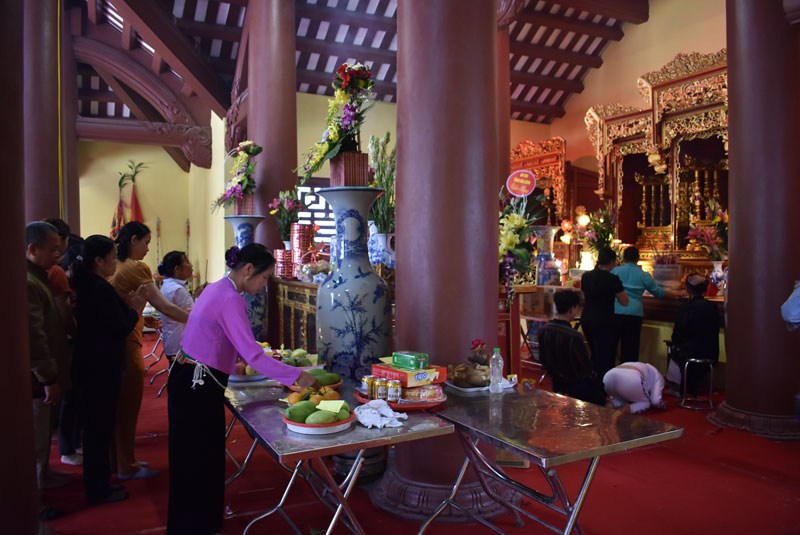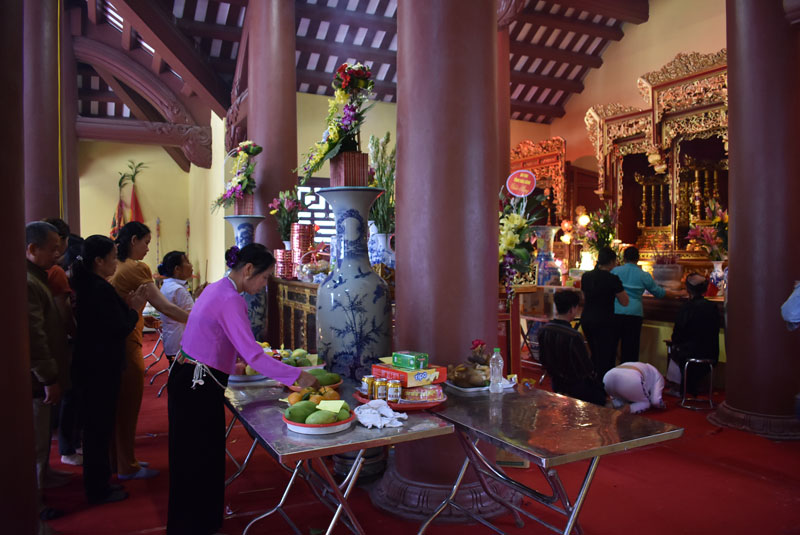
(HBO) - Historically, Quen Thi village in Cao Duong commune, Luong Son district was born a few hundred years ago. At first, there were only seven households from other places to settle here. Later, it developed into a village called Trai Mit village, which is now called Quen Thi village. About 300 years ago, the people of Quen Thi village built a communal house to worship the Gods Tan Vien Son, Cun Truong Thung, and the Citadel of the village.
Quen Thi Communal House in Cao Duong commune (Luong Son) was built nicely, meeting the spiritual needs of the local people.
It is not only is a religious place, the village communal house is also a meeting place to discuss the village’s matters. The communal house was built in the middle of the field, looking the south. In the east, west and north there are limestone mountains that cover the village campus. Quen Thi communal house has been expanded into seven compartments, with a harem and it was built with precious wooden. The communal house was degraded over the time. In 1996, the people of Quen Thi village contributed their labor and money to rebuilding the communal house at the right old place to worship the gods, Tan Vien Son and the Citadel of the village.
During the year, Quen Thi communal house often holds five main festivals, in which the spring festival on the 12th of January is held the most solemnly. The festival includes the ceremony to hold the palanquin procession of Duc Mau's incense bowl to the eldest communal house. After the ceremony stopped at the right place, the folk games, antiphonal singing, cultural and sports activities take place. These activities always attract the people of the whole village to participate. On April 4 of the lunar calendar, the communal house held a ceremony to pray for water plating. The village’s shaman prays for good rain, good weather and good crops. On 12 June of the lunar calendar is a ceremony to go to the field. The village’s shaman prays the gods, the heaven and earth for the permission to go to the field. After the ceremony, the villagers are allowed to go transplanting in the fields. The 18th August of lunar month is a ceremony to wash rice leaves. At this time, rice is standing and easily being damaged by pests and other diseases. The people in the village pray for good weather and no pests and diseases can destroy the crops. On the 12th of October, the new rice ceremony is celebrated. At this time, rice begins to be collected home. This is a ceremony to thank the gods, the heaven and earth to have helped them with the good harvest, the prosperous and healthy business and good health.
Gongs hold a special place in the cultural and spiritual life of the Muong ethnic people in Hoa Binh province. More than musical instruments, they are an indispensable part of community rituals and collective memory, echoing through generations as a spiritual thread linking the past, present, and future.
Preserving and promoting the cultural values of the Muong ethnic group has become an urgent task in the current context, as many traditional values face the risk of fading away. This effort requires not only protecting the cultural identity but also eliminating outdated customs and developing a modern cultural lifestyle, contributing to sustainable values for the Muong community in Hoa Binh province.
The Muong ethnic culture, deeply rooted in Vietnam’s mountainous north, continues to be preserved and revitalised by dedicated individuals and communities determined to safeguard their ancestral identity.
The Muong group is one of the largest ethnic minorities in Vietnam, primarily found in Hoa Binh province. The Muong people in Hoa Binh boast a rich and diverse cultural treasure that reflects the unique identity of this ethnic group. Accounting for over 63% of the province's population, they have created and preserved numerous distinctive cultural values, contributing to their unique identity. Their cultural heritage is an invaluable asset, at the heart of their national identity, and represents a vibrant spiritual life that must be preserved and promoted in today’s modern world.
For generations, the ethnic communities of Hoa Binh province, particularly the Muong people, have preserved vibrant festivals deeply intertwined with the region’s geography, nature, and social traditions. These celebrations enrich Hoa Binh’s spiritual life and cultural identity, reflecting both folk beliefs and the intermingling of ethnic customs. Many of these festivals have endured the test of time, passed down through generations and continuing to thrive today. Among them, the Khai Ha (Going Down to the Field) festival stands out as one of the most significant events of the Muong ethnic group.
Muong calendar, known as sach doi, is an ancient folk knowledge system developed through observations of the movement of the pleiades star. This unique calendar consists of 12 bamboo sticks, each representing a lunar month. Specific days within each month are marked with distinct symbols, guiding locals in determining auspicious and inauspicious days for important activities.



